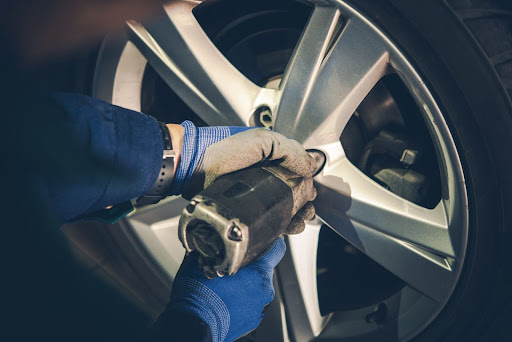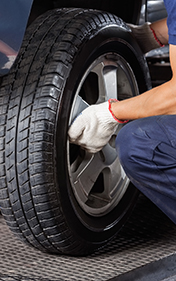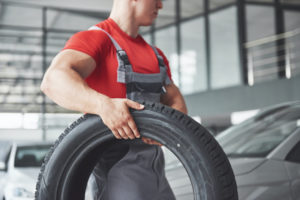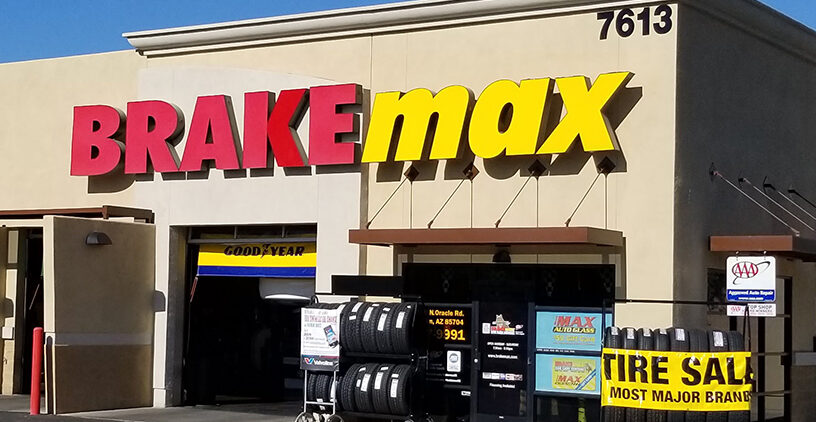Guide to Tire Rotation Service in Tucson: How to Maximize Your Tire Life

Your vehicle’s tires play a critical role in helping you get to your destination every day. They also help ensure that you and your passengers are safe while traveling on the roadways. That is why it is so important to consistently keep your tires in the best condition possible. The best way to do that is by including them in your vehicle’s preventive maintenance routine.
Regularly scheduled tire rotation is one of the maintenance services that can help keep your tires in optimal shape. This tire service helps maintain the driveability and safety of your tires and ensures optimal performance while also helping to maximize your investment in new tires.
In this guide, we’ve taken a deep dive into everything you need to know about tire rotation straight from our Tucson tire shop pros.
What Is a Tire Rotation?
A tire rotation service involves repositioning each tire on a car in a specific pattern based on the type of tire and type of vehicle.
One of the most common movement patterns for this tire service is to move the rear tires to the front and the front tires to the rear. Alternatively, the driver’s side tires are sometimes switched with the passenger side tires straight across the vehicle. And, on certain vehicles, the tires are rotated in a combination of these two movements. In this case, the tires are moved in an “x” pattern for best performance.
Why Routine Tire Rotation Service Is So Important
Tire rotation has two main goals: to help maintain even tire tread wear and to catch any tire damage early. There are several reasons why these two things are so important.
In most vehicles on the road today, the engine is located in the front, and most of the vehicle’s weight is centered over the front axle. This higher weight, compared to the rear of the vehicle, causes the front tires to wear faster. Plus, more stress is put on the front tires when braking and steering than on the rear tires.
Your tires also naturally suffer uneven wear due to turning the vehicle. Because most of the pressure when turning is on the outside of the tread, the outer edge of the tire endures more wear when turning than the inside or middle of the tire.
pressure when turning is on the outside of the tread, the outer edge of the tire endures more wear when turning than the inside or middle of the tire.
Additionally, since we drive on the right side of the road here in the U.S., the front left tire travels further around most turns. So, this tire usually wears faster than the front right tire. (This would be the opposite in places where you drive on the left side.)
Mechanical problems can sometimes cause uneven tire tread wear, too. This is especially true with vehicle alignment or suspension issues like problems with the upper or lower control arms or ball joints.
Uneven tread wear caused by the abovementioned things can quickly create an unstable and unsafe interface with the road. This leads to issues like the following:
- Poor traction in rainy, icy, and snowy conditions
- Hydroplaning
- Excess heat buildup within the tire
- Increased risk of blowouts and punctures when driving
So, staying on top of your vehicle’s recommended tire rotation schedule will help ensure that tire tread wear is evenly distributed across all four of your tires. (See below for more details on the specific benefits.)
What Happens During a Tire Rotation Service
For this tire service, once your vehicle is up on the lift, the mechanic will remove each tire/wheel assembly and move it from one position on the vehicle to another. The exact movement pattern depends on the specific type of tire, if the vehicle is front- or rear-wheel drive, and how/where the tires were moved during your last tire rotation.
In the scenario where there are two new tires and two worn tires on the vehicle, the newer tires will be put on the rear of the vehicle to prevent fishtailing. This is the case regardless of the vehicle’s drive type.
While your vehicle is in the tire shop for rotation, the mechanic will also thoroughly inspect the tires, checking for any damage or other issues that could negatively impact tire performance and/or safety. They will:
- Examine the tread wear on each tire
- Look for any damage or embedded foreign objects
- Check and adjust the air pressure in each tire as needed
- Tighten any loose wheel lug nuts
Catching any minor issues early will prevent them from developing into a major problem down the road (one that usually equals a need for tire replacement).
If you have noticed any vibrations in your steering wheel or seat recently, the mechanic can also check the balance of your tires during the tire rotation. Since the rotation already involves taking the wheel/tire assemblies off of the vehicle, it is easy to do a tire balancing service at the same time if needed.
The expert Tucson auto mechanics at your nearest BRAKEmax location can properly perform tire rotation, alert you to any tire issues if present, and help you select the best replacement tires when it's time.
How Often Should You Have a Tire Rotation Done?
The answer to this question depends on a few variables. On new tires, the deeper tread is more susceptible to uneven wear. So, it is best to have them promptly rotated at the 5,000-mile mark.
If the tires have driven more than 5,000 miles, the schedule for tire rotation service will depend on the type of vehicle, what is recommended by the vehicle and tire manufacturers, and your driving habits. Generally speaking, a tire rotation should be done anywhere from every 3,000 to 7,000 miles.
For example, if your vehicle is front-wheel drive (FWD) or rear-wheel drive (RWD), it is usually recommended that a tire rotation is done every 5,000 to 7,000 miles. If you frequently drive in challenging conditions or are an aggressive driver, the lower end of this range is best.
If your vehicle is all-wheel drive (AWD), the tires will all wear at varying rates, so they should be rotated every 3,000 to 5,000 miles. Again, if you frequently drive in rough terrain, stick to the lower end of this range.
For the exact recommendation of tire rotation frequency for your vehicle, look in your vehicle owner’s manual. A good habit to get into is to have a tire rotation and inspection done while your vehicle has an oil change service.
Seven Key Benefits of Routine Tire Rotation Service
Routine tire rotation service is one of the easiest and cheapest ways to maximize the lifespan and performance of your tires and your vehicle as a whole. Here are seven valuable benefits of staying on top of a routine tire rotation schedule:
1. Maximizes the Tire Tread’s Lifespan
As mentioned above, one of the biggest benefits of regular tire rotation service is that it helps to evenly distribute tread wear, extending the life of your tires.
For example, tire rotation helps prevent the tire tread from “cupping.” This uneven wear pattern looks like part of the tread was scooped out with an ice cream scoop every three to four inches all the way around the tire.
This is an issue that can quickly escalate the longer it is ignored. Not only does it wear down the tread much faster, but tire cupping can negatively impact the vehicle’s steering and braking ability, increasing the risk of an accident.
2. Helps To Keep The Vehicle Safe on the Road
When the vehicle’s tires are wearing evenly, it also helps ensure the vehicle is safe to drive. Firstly, uneven tread wear patterns can significantly hinder vehicle handling and put you at a greater risk of losing control.
Secondly, during a tire rotation service, your mechanic can catch any tire issues early before they become bigger problems. For example, overly damaged tires are at high risk of a blowout.
3. Helps Maintain the Overall Driving Performance of Your Vehicle
When tire rotation service is done consistently, you can feel it in the way your vehicle drives. When the tires grip the road properly, the vehicle will have better handling and responsiveness. This means you’ll enjoy a smooth ride with optimal steering and braking and no added vibration and road noise.
Your tires can perform at their best when the tread wear is evenly balanced. This is especially helpful in environments with significant rainy seasons or snowy winters where you need optimal traction.
4. Maximizes Fuel Efficiency
Regular tire rotations are an easy way to help maximize your vehicle’s fuel efficiency. Uneven tire tread wear puts a greater strain on your engine, forcing your engine to work harder to generate the necessary amount of power. This causes a decrease in gas mileage.
So, keeping up with regularly scheduled tire rotations can help increase your vehicle’s stability and traction and reduce excess engine stress, helping to reduce the likelihood of spending more money at the gas pump than you should.
5. Reduces Excess Stress on Other Related Vehicle Components
Not only can you slow down the wear on your tires with regular tire rotation, but it also decreases the wear on your suspension components, brake system, and drive train (on all-wheel drive vehicles).
For example, a tire rotation service ensures that the vehicle is proportionally balanced on its suspension components. This reduces the stress put on parts such as the shocks, struts, and springs.
6. Saves You Money on Other Maintenance Costs Over the Long Run
The cost of tire rotation in Tucson is much lower than the cost of replacing related components due to uneven tread wear. Investing your money and time in routine tire rotations will actually help save you a lot of money later on.
New tires, rims, suspension parts, or brakes are not cheap. As mentioned above, periodically visiting your local Tucson tire shop for tire rotation service will allow any small problems to be caught early when they cost less to fix.
7. Protects the Warranty on Your Tires
The tire manufacturer, in many cases, requires you to have regular tire rotation service done to maintain the tread life warranty coverage on the tires. So, it is very important to confirm if this applies to your tires. Ensuring you do everything you can to protect your tire warranty can save you a good amount of money if the tires need to be replaced sooner than expected.

Which Tire Rotation Pattern Is the Best for Your Vehicle?
There are several factors that determine the best tire rotation pattern for your vehicle, including:
- The specific type of tire
- If the vehicle is front-, rear-, or four-wheel drive
- Whether the tires are non-directional or directional
- Whether all four tires are the same size
- Whether you have a full-size spare that can also be included in the rotation pattern
In all of the above cases, the standardizing body for the tire industry, The Tire and Rim Association, Inc., has several recommended tire rotation patterns:
For Non-Directional Tires That Are All the Same Size
Forward Cross
This is the most common movement pattern used on front-wheel drive vehicles. The front axle’s tires are moved straight to the back, while the rear tires are moved diagonally forward to the opposite side of the front axle.
Rearward Cross
The rearward cross pattern can be used on rear-wheel, all-wheel, and four-wheel drive vehicles. In this pattern, the rear tires are moved straight to the vehicle’s front axle, while the front tires move back diagonally to the opposite side on the rear axle.
X-Pattern
This movement is usually recommended for sedans and lightweight trucks that are front-wheel drive. For this pattern, the tires are moved in a diagonal “x,” switching them from one axle to the other on the opposite side of the vehicle.
For Tires That Are Non-Directional and All the Same Size, Plus a Full-Sized Spare
When a full-size spare is present, it should be included in the rotation pattern along with the other four tires to ensure they will have more even tire wear. This is especially important on all-wheel or four-wheel drive vehicles where even a minute difference in tread wear can put excess strain on the vehicle’s drivetrain.
Forward Cross (Front-Wheel Drive Vehicles)
With this pattern, the rear tires are moved diagonally to the front axle on opposite sides of where they were, while the previous front right tire becomes the new spare. The previous spare tire goes to the rear axle on the right side, while the front axle’s left tire goes to the left rear position.
Rearward Cross (on Rear-Wheel or Four-Wheel Drive Vehicles)
For this movement pattern, both rear axle tires go directly forward to the front axle, while the previous spare tire goes to the rear axle’s right side. The previous right front tire goes diagonally to the rear axle’s left side, while the previous left front tire will become the new spare tire.
For Directional and High-Performance Tires
Front-to-Back (With Directional Tires)
The tires are all moved straight from one axle to the other while staying on the same side of the vehicle. For example, the front right tire is moved to the rear axle's right side, while the front left tire is moved to the rear axle’s left side.
Side-to-Side (With Performance Tires That Are Different Sizes Between the Front and Rear Axles)
Each tire is swapped with its same-sized match on the same axle. So, each of the two front tires is switched to the opposite side while the rear two tires do the same.
Six-Tire Rotation (On Dually Trucks)
On trucks with dual rear wheels, the tire rotation pattern will follow two triangles, one on the driver’s side and one on the passenger's side. For each side, the inner dual tire goes to the front, the previous front tire goes to the outer dual position, and the previous outer dual tire is moved to the inner position.
Optimize Your Tires’ Safety and Performance With Tire Rotation Service in Tucson
When you need a tire shop that performs professional tire rotation, visit the experts here at BRAKEmax Tire & Service Centers. Our ASE-certified mechanics can maximize your tires’ performance while providing top-notch service. We can help you determine the proper schedule for your vehicle’s tire rotations.
And along with tire rotation service, we also specialize in a full range of tire/wheel services, including:
- Flat tire repair
- Wheel/tire balancing
- Wheel alignments
- Tire Pressure Monitoring System (TPMS) repair
And whether you need replacement tires or tire alignment in Tucson, we’ve got you covered! We’ll help make sure that you get the best new, high-quality tires for your vehicle and that they are aligned to provide optimal driveability.
Here at BRAKEmax, we aim to be your trusted one-stop auto service shop and will meet all of your vehicle’s needs at reasonable prices.









